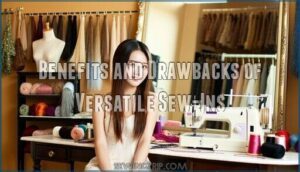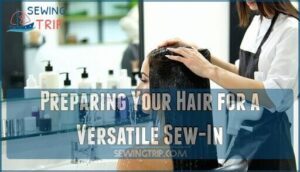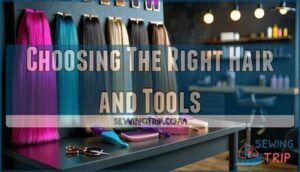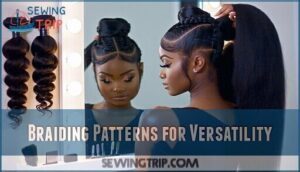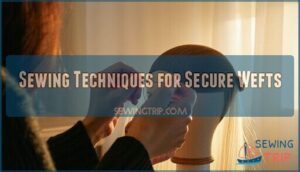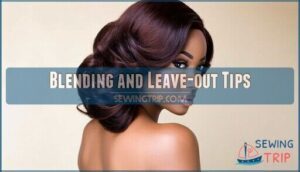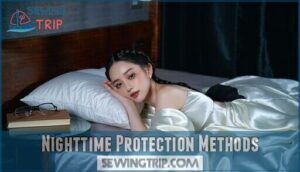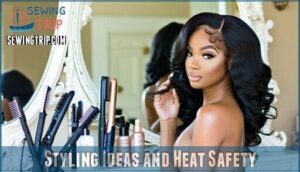This site is supported by our readers. We may earn a commission, at no cost to you, if you purchase through links.
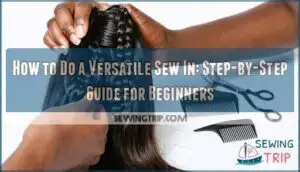
You’ll start with clean, conditioned hair and create strategic braid patterns that allow multiple parting options.
Choose human hair extensions matching your natural texture, then sew wefts using loose techniques that enable 360-degree styling.
Leave out enough natural hair around your perimeter for seamless blending.
The key difference is that instead of fixed braids that lock you into one style, you’ll create flexible anchor points that move with your hair.
This technique lets you rock ponytails, updos, or flowing styles without reinstalling.
Proper preparation and the right sewing method transform weeks of hair monotony into endless styling possibilities that actually protect your natural hair underneath.
Table Of Contents
Key Takeaways
- Create flexible braid patterns – Use techniques like the vixen pattern or diagonal cornrows that allow multiple parting options instead of fixed braids that lock you into one style
- Leave out enough natural hair – Keep sufficient perimeter and crown hair exposed to blend seamlessly with your extensions and enable 360-degree styling freedom
- Use proper sewing techniques – Secure wefts with double-stitching and matching thread while maintaining loose enough tension to allow natural hair movement without scalp damage
- Maintain with gentle daily care – Protect your investment with silk accessories, weekly sulfate-free washing, and heat tools under 350°F to extend your install’s lifespan
What is a Versatile Sew-In?
A versatile sew-in gives you the freedom to part your hair anywhere and style it multiple ways, unlike traditional sew-ins that limit you to one fixed part.
Break free from one-style limitations and create countless looks with strategic parting freedom
You’ll leave out more of your natural hair around the perimeter and crown, creating a seamless blend that looks completely natural.
Key Features and Definition
A versatile sew-in hair extension method allows you to create multiple parting options and styling flexibility.
Unlike standard sew in techniques that limit your hair texture choices, this approach accommodates various hair types through strategic sew patterns.
Here are the key features:
- Multiple parting directions – You can part your hair anywhere across the scalp
- Leave-out compatibility – Blends seamlessly with your natural hair texture
- 360-degree styling – Allows ponytails, updos, and side parts without restrictions
- Layered installation – Uses specific hair sewing patterns for natural movement
- Customizable density – Adjusts thickness based on your preferred versatile styles
Differences From Traditional Sew-ins
Traditional sew-ins lock you into one style, but versatile sew in hair breaks those chains.
Standard hair weaving uses tight sew patterns that create fixed parts, limiting your styling freedom.
The versatile sew in method employs strategic sew techniques with looser weft types, allowing multiple parting options.
Different hair texture and hair length combinations work with this hair extension approach, giving you control over your look without reinstallation, using strategic sew techniques.
Who Should Consider a Versatile Sew-in
Looking for the perfect hair extension method that’ll give you total styling freedom? You’re probably a great candidate for versatile sew in hair if you fall into these categories:
- Active lifestyles – Need a hair weaving solution that survives workouts and busy schedules
- Style chameleons – Want to switch between updos, ponytails, and down styles effortlessly
- Hair goals seekers – Desire length and volume while protecting natural hair
This sew in method works best for sew candidates with healthy hair. Understanding the basics of hair extension techniques is essential for a successful sew-in installation.
Benefits and Drawbacks of Versatile Sew-Ins
Before you commit to a versatile sew-in, you’ll want to weigh the pros and cons to make sure it’s the right choice for your lifestyle and hair goals.
Understanding both the benefits and potential challenges helps you set realistic expectations and prepare for proper maintenance.
Styling Versatility and Parting Options
One major advantage of the versatile sew in process lies in its incredible Hair Parting freedom.
You can switch between middle parts, side parts, and even zigzag patterns without redoing your braids.
This hair extension method supports various Styling Tools like flat irons and curling wands for different looks.
| Parting Style | Best Hair Texture |
|---|---|
| Middle Part | Straight to wavy |
| Deep Side Part | All textures |
| Zigzag Part | Curly preferred |
| Crown Part | Medium density hair |
The strategic leave-out sections blend seamlessly with your natural hair, making style changes feel effortless.
Whether you’re going for sleek ponytails or textured updos, Versatile Cuts accommodate your mood.
The Sew Patterns create anchor points that support multidirectional hair styling without compromising the install’s integrity.
Longevity and Hair Protection
Proper hair sew installation protects your natural hair from daily manipulation and environmental damage.
When done correctly, your hair installation acts like armor, preventing hair breakage while promoting scalp health and maintaining hair thickness. However, tension and poor hair care during the sew in process can cause damage.
Understanding hair extension risks is essential for a successful installation.
Here are three key protective benefits:
- Reduced daily styling stress – Your natural hair stays tucked away from heat tools and harsh brushing
- Length retention – Protective styles like hair sew ins minimize split ends and breakage from constant handling
- Moisture preservation – Proper hair sew techniques seal in natural oils, keeping your hair hydrated underneath
Common Challenges and Cons
Versatile hair sew installations aren’t foolproof adventures.
Hair shedding becomes your daily companion, especially with synthetic options. Tension problems from tight braiding patterns can trigger serious hair loss around your edges.
Itching issues plague many clients when scalp care gets neglected during the hair installation process. Breakage risks multiply if you’re heavy-handed with styling tools on your sew in hair extension technique, leading to significant hair loss.
Preparing Your Hair for a Versatile Sew-In
Proper preparation sets the foundation for a successful versatile sew-in that looks natural and lasts longer.
You’ll want to start with clean, well-conditioned hair and a healthy scalp to guarantee the best installation results.
Washing and Conditioning Tips
Start your hair weave preparation with sulfate-free shampoo methods that won’t strip natural oils. Apply a deep conditioning hair mask for 20 minutes, focusing on moisture balance through gentle scalp massage.
Use conditioner tips like cool water rinses to seal cuticles. This hair installation method requires properly hydrated strands before your sew in hair extension technique begins.
To maintain a healthy sew in, understanding proper washing techniques is essential for long-lasting results, using properly hydrated strands and following the right sew in hair extension technique for a healthy sew in.
Scalp Care Before Installation
A healthy scalp sets the foundation for your sew in hair extension success.
After washing, focus on scalp massage using gentle circular motions to boost circulation and loosen dead skin cells.
Follow these pre installation steps:
- Apply a clarifying scalp treatment to remove buildup and create the perfect canvas
- Perform gentle cleansing with a sulfate-free shampoo to avoid irritation
- Complete your hair prep with a lightweight moisturizer to prevent dryness
This hair installation method requires patience, but proper scalp care prevents itching and extends your hair weave’s lifespan.
Best Hair Types for Versatility
Why stress about hair choices when the right Hair Texture and Curl Patterns make all the difference? Your natural hair’s characteristics determine which Fiber Types work best for seamless blending.
| Hair Characteristic | Best Match for Versatility |
|---|---|
| Coarse/Thick Texture | Human hair with matching density |
| Fine/Thin Strands | Lightweight synthetic or silk-pressed human hair |
| Tight Curl Patterns | Kinky or coily textures for natural blending |
Consider your Scalp Conditions and Hair Length when selecting extensions. This hair sew technique requires proper matching for successful hair styling technique results in Managing Health and Healthcare and Medicine applications.
Choosing The Right Hair and Tools
Selecting quality hair and proper tools sets the foundation for a successful versatile sew-in that looks natural and lasts.
You’ll need to take into account hair type, quantity, and essential equipment before starting your installation process.
Human Hair Vs. Synthetic Hair Options
Now that you’ve prepped your hair, choosing between human hair and synthetic fiber options makes or breaks your versatile sew-in experience.
Human texture offers superior hair durability and styling flexibility, while synthetic fibers limit your creative freedom.
Consider these key differences when selecting your hair sew technique materials:
- Hair quality: Human hair maintains natural movement and blends seamlessly with your leave-out
- Heat tolerance: Human hair withstands styling tools; synthetic fibers melt under high temperatures
- Longevity: Human hair lasts 8-12 weeks versus synthetic’s 2-4 week lifespan
- Styling options: Human hair supports multiple hair styling technique variations; synthetic offers limited formal writing of looks
Human hair provides technical specificity for advanced techniques, while synthetic works for basic installations using concrete terms and straightforward methods.
For the best results, understanding human hair extensions is essential to achieve a natural look.
How Much Hair You Need
You’ll need 2-3 bundles of hair for most versatile sew-ins, depending on your hair density goals.
Thicker hair length requires more bundles to achieve proper hair volume and weight distribution. Your natural hair quantity affects how much you’ll need – fine hair needs less, while coarse hair demands more.
What you do with your styling preferences matters too. If you do well with fuller looks, grab that extra bundle. The hair weight should feel balanced, not overwhelming your scalp or braids underneath.
Understanding hair bundle options is essential for a successful sew-in.
Essential Tools and Products
Once you’ve secured quality hair, gathering the right tools will make or break your installation success.
Professional-grade equipment helps you do something extraordinary with ordinary materials.
- Sewing Needles: Heavy-duty curved needles slice through braids without snagging
- Hair Threads: Strong polyester thread matches your hair color perfectly
- Weft Brushes: Gentle bristles smooth extensions without causing damage
- Braiding Combs: Rat-tail combs create precise parts for clean sections
- Adhesive Glues: Edge control keeps baby hairs tamed throughout styling
Quality tools do well what cheap alternatives do badly – they last longer and deliver professional results every time.
Using the right measuring tools is essential for achieving a seamless and professional finish in hair sewing installations.
Step-by-Step Versatile Sew-in Installation
Now you’re ready to put everything together and create your versatile sew-in from start to finish.
The installation process involves three main steps: creating the right braid pattern, securing your wefts properly, and blending everything for a natural look.
Braiding Patterns for Versatility
Your braiding foundation determines styling freedom.
The vixen pattern offers maximum versatility with four quadrants and mini beehives, perfect for center or side parts.
You’ll do well with u-part leave-out for natural-looking partings.
Diagonal cornrow designs create angled parts for swooped styles.
Perimeter anchor braids outline leave-out areas while maintaining flat edges.
Choose patterns that do something specific for your styling goals.
To achieve a flawless sew-in, consider the importance of sew in patterns when planning your hairstyle, focusing on a specific style and using the right techniques.
Sewing Techniques for Secure Wefts
Mastering weft attachment transforms your sew-in from amateur hour to salon-quality perfection. Strategic thread selection and proper sewing patterns create bulletproof hair tracking that won’t budge through styling marathons.
- Double-stitch each weft edge to prevent unraveling disasters
- Use matching thread color for invisible weave reinforcement
- Pull thread tight enough to secure but not scalp-damaging tight
- Backstitch at weft ends for maximum hold and longevity
Smart sewers do something most beginners skip—they conduct a mini feasibility study on thread tension before committing. You’ll do well with cotton thread over synthetic options. Abstract notions about "perfect tension" become clear when you do with something tangible: practice on a mannequin first.
Blending and Leave-out Tips
Hair blending becomes your secret weapon for seamless leave-out sections.
Trim your natural hair gradually to match extension lengths, creating smooth shifts. Color matching guarantees your roots blend perfectly with the wefts.
Edge control helps tame flyaways while hair texturing adds natural movement.
You’ll do well when you practice these techniques consistently, avoiding the badly blended look that screams artificial installation by doing something extra like layering different textures to achieve a more natural appearance, and ultimately mastering the art of seamless leave-out sections.
Maintaining and Styling Your Versatile Sew-In
Your versatile sew-in is installed, but proper maintenance will determine how long it lasts and how good it looks.
The right daily care routine and styling techniques can extend your install for weeks while keeping your natural hair healthy underneath.
Daily Care Routines and Product Use
Daily Care Routines keep your sew-in looking fresh and healthy. Apply lightweight moisturizer to your scalp every few days for Scalp Health and Hair Hydration.
Use sulfate-free shampoo weekly for proper Hair Maintenance. Choose gentle products that won’t cause buildup.
Daily Styling should include detangling with a wide-tooth comb from ends to roots. Product Selection matters—avoid heavy oils that weigh down extensions.
For ideal results, follow a sew in guide to maintain your sew-in weft.
Nighttime Protection Methods
Protecting your versatile sew-in while you sleep prevents tangling and maintains your investment.
Sleep caps or satin scarves create a barrier between your hair and cotton pillowcases. Silk pillowcases reduce friction naturally.
Loose night braids keep longer extensions organized without tension. Avoid tight hair ties that create dents.
Healthcare providers often recommend silk accessories as preventative medicine for hair health. These simple health tips from patient care experts protect your style overnight.
Styling Ideas and Heat Safety
Why struggle with flat, lifeless hair when your versatile sew-in offers endless styling possibilities?
Heat tools below 350°F protect hair texture while thermal protection products prevent hair damage.
Try flexi rods for heatless curls or silk press techniques for sleek looks.
Styling products with etymological meanings from French verb "faire" (feasible options) help achieve your desired results safely.
Frequently Asked Questions (FAQs)
Can I swim or go to the beach with a versatile sew-in?
Ocean adventures await, but versatile sew-ins need protection.
You can swim with waterproof sealant around tracks, but saltwater’s harsh.
Rinse immediately afterward, deep condition weekly, and expect a shorter lifespan than usual.
How often should I wash my versatile sew-in?
You should wash your versatile sew-in every 2-3 weeks, depending on your lifestyle and hair type.
If you’re active or use heavy products, you might need weekly washes to keep it fresh.
Can I use heat styling tools on my leave-out hair?
Heat styling tools can damage your leave-out hair if you’re not careful.
You’ll want to use heat protectant spray and keep temperatures below 350°F to maintain healthy hair that blends seamlessly.
Can I sleep comfortably with a versatile sew-in?
You’ll sleep fine with proper prep.
Use a silk pillowcase, wrap your leave-out hair, and position yourself to avoid direct pressure on the wefts.
Your scalp might feel tight initially, but you’ll adjust within a few nights.
How much does versatile sew-in installation cost?
You’ll typically pay between $150-$400 for versatile sew-in installation, depending on your stylist’s experience, location, and hair length. Expect higher costs in major cities and premium salons.
Can you swim with a versatile sew-in?
Swimming with a versatile sew-in isn’t recommended.
Water exposure can loosen the tracks, cause tangling, and promote bacterial growth.
If you must swim, wear a swimming cap and rinse immediately afterward with clean water to minimize damage.
How often should you remove versatile sew-ins?
Picture tangled hair and scalp irritation from overworn extensions.
You should remove versatile sew-ins every six to eight weeks maximum.
This timeframe prevents matting, breakage, and allows your natural hair to breathe and recover properly, which is crucial for maintaining healthy hair.
Does versatile sew-in damage natural hair growth?
Versatile sew-ins won’t damage your natural hair growth when installed and maintained properly. You’ll protect your hairline by avoiding excessive tension during installation. Regular moisturizing keeps your scalp healthy underneath.
Can you color hair after sew-in installation?
You can color your hair after sew-in installation, but it’s tricky business.
The extensions won’t take dye like your natural hair, creating uneven results.
Wait until removal for best color outcomes, as this is the best approach to achieve the desired hair color.
Conclusion
Like a masterfully woven tapestry, learning how to do a versatile sew in transforms your hair game completely.
You’ve now mastered the braiding patterns, sewing techniques, and blending methods that create true styling freedom.
Remember to maintain your install with gentle daily care and proper nighttime protection.
With practice, you’ll perfect this technique and enjoy weeks of effortless styling options.
Your natural hair stays protected while you experiment with countless looks that suit any occasion or mood.

